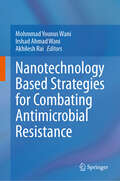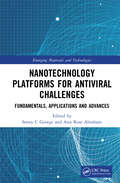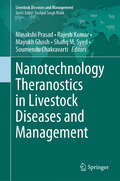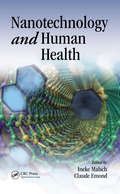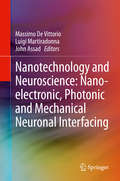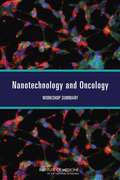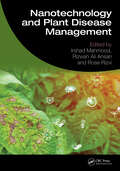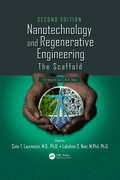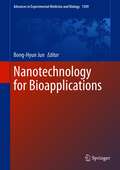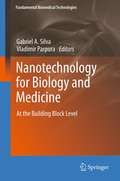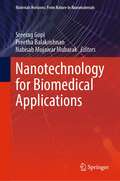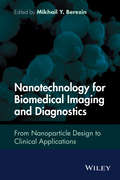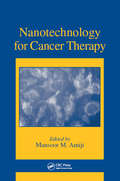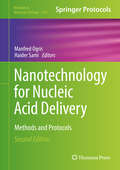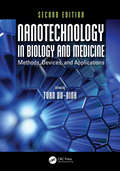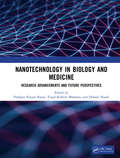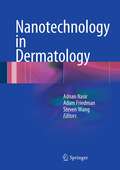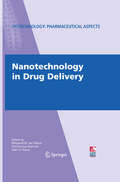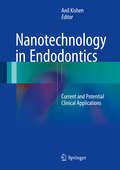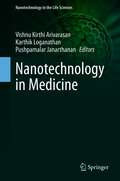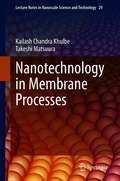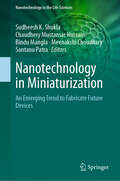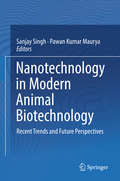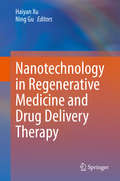- Table View
- List View
Nanotechnology Based Strategies for Combating Antimicrobial Resistance
by Mohmmad Younus Wani Irshad Ahmad Wani Akhilesh RaiThis book provides a comprehensive overview of recent advances in nanotechnology as an alternative strategy for addressing antimicrobial resistance (AMR). Examining nanotechnology-based methods such as nanoencapsulation, drug delivery, and conjugation, the text highlights their successful application in treating microbial infections with reduced resistance and off-target toxicity. The introductory section outlines AMR and explores diverse mechanisms of microbial resistance, emphasizing the potential of nanotechnology to surmount these challenges. Subsequent chapters investigate the role of specific nanomaterials—metal nanoparticles, metal oxide nanoparticles, functionalized quantum dots, magnetic nanoparticles, bimetallic nanoparticles, nanocomposites, carbon nanomaterials, and polymer-based nanomaterials—in overcoming antimicrobial resistance. Several chapters focus on the efficacy of nanoemulsions as an antimicrobial delivery method, underscoring their inherent antimicrobial properties, capacity to enhance drug solubility, stability, bioavailability, and targeting potential at the organ and cellular levels. The concluding section provides a detailed review of liposomes, dendrimers-based nanoparticles, and micelles as drug delivery vehicles in the context of combating pathogens resistant to antimicrobials.
Nanotechnology Platforms for Antiviral Challenges: Fundamentals, Applications and Advances (Emerging Materials and Technologies)
by Soney C George and Ann Rose AbrahamNanotechnology provides an innovative platform for drug delivery and antiviral actions. This book discusses the utilization of nano-based formulations for the control of viral agents. The antiviral potential of green synthesized silver, chitosan nanoparticles encapsulating curcumin, photoinduced antiviral carbon nanohorns, and the role of carbon-based materials like fullerenes, and carbon nanotubes in the repression of viral antigens are explained. The book also covers nanomaterial-based solutions for SARS-CoV-2 and other viral infections. Features: Explains theory and practical applications of nanomaterials as antiviral agents. Reviews upscaling of nanomaterials from laboratory to fabrication stage. Illustrates nanocurcumin, silver nanoparticles, and carbon nanoparticles for biomedical applications. Highlights role of nanotechnology in effectively combating viral infections and pandemics. Includes case studies of specific pharma companies. This book is aimed at researchers, graduate students in materials science, microbiology and virology, and pharmaceutical sciences.
Nanotechnology Theranostics in Livestock Diseases and Management (Livestock Diseases and Management)
by Rajesh Kumar Minakshi Prasad Mayukh Ghosh Shafiq M. Syed Soumendu ChakravartiThis book reviews various applications of nanotechnology in the prophylactic, diagnostic, and therapeutic management of livestock diseases. The initial section discusses the strategies for the synthesis of nanomaterials and characterization of different nanomaterials. The subsequent chapters explore the role of nanoparticles in the diagnosis of diseases caused by pathogenic microorganisms, including bacteria, viruses, protozoans, and fungi. The book also examines the nano sensors that are used for point-of-care diagnosis of various livestock diseases. Additionally, it highlights nanoparticles-based vaccines and vaccine delivery systems to combat bacterial livestock diseases. Lastly, the book entails the strategies for developing nanotherapeutics for the treatment of bacterial, viral, fungal diseases, metabolic disorders, and cancer in livestock animals. The content of this book is useful for researchers and practitioners interested in understanding the applications of nanotechnology in diagnostics and therapeutics of livestock diseases.
Nanotechnology and Human Health
by Paul C. H. LiAddressing medium- and long-term expectations for human health, this book reviews current scientific and technical developments in nanotechnology for biomedical, agrofood, and environmental applications. This collection of perspectives on the ethical, legal, and societal implications of bionanotechnology provides unique insight into contemporary te
Nanotechnology and Neuroscience: Nano-electronic, Photonic and Mechanical Neuronal Interfacing
by Massimo De Vittorio Luigi Martiradonna John AssadThis book describes the use of modern micro- and nanofabrication technologies to develop improved tools for stimulating and recording electrical activity in neuronal networks. It provides an overview of the different ways in which the "nano-world" can be beneficial for neuroscientists, including improvement of mechanical adhesion of cells on electrodes, tight-sealed extracellular recordings or intracellular approaches with strongly reduced invasiveness and tools for localized electrical or optical stimulation in optogenetics experiments. Specific discussion of fabrication strategies is included, to provide a comprehensive guide to develop micro and nanostructured tools for biological applications. A perspective on integrating these devices with state-of-the-art technologies for large-scale in vitro and in vivo experiments completes the picture of neuronal interfacing with micro- and nanostructures.
Nanotechnology and Oncology
by Margie PatlakOne way scientists are working to overcome challenges in cancer treatment and improve cancer care is through nanotechnology. Nanotechnology, engineered materials that make use of the unique physical properties, presents a new array of medical prospects that will revolutionize cancer prevention, diagnosis, and treatment practices. Giving new hope to patients, practitioners, and researchers alike, nanotechnology has the potential to translate recent discoveries in cancer biology into clinical advances in oncology. While public investments in nanotechnology for cancer continue to increase, medical products based on nanotechnology are already on the market. The National Cancer Policy forum held a workshop July 12-13, 2010, to explore challenges in the use of nanotechnology in oncology. Nanotechnology and Oncology evaluates the ongoing discussion on the role of nanotechnology in cancer as it relates to risk management, treatment, and regulatory policy. Assessments on nanomedicine and the physical properties of nanomaterials were presented during the workshop, along with an appraisal of the current status of research and development efforts.
Nanotechnology and Plant Disease Management
by Rizwan Ali Ansari Irshad Mahmood Rose RizviNanotechnology and Plant Disease Management explores the intersection of nanotechnology and agriculture. This book serves as a comprehensive exploration of the current state and future potential of nanoparticles in revolutionizing plant disease management within the realm of agriculture. This book elucidates the synthesis, characterization and judicious application of nanoparticles, providing a clear and accessible explanation of what nanomaterials are, how they are characterized, and their pivotal role in reshaping the plant disease management systems. It scrutinizes innovative strategies that influence the unique properties of nanoparticles to identify and monitor the presence of pathogens at early stages. The book also examines the limitations inherent in the use of nanomaterials for disease management in plants by critically evaluating both sides of the spectrum. This aims to provide a candid overview of the hurdles that must be overcome to unlock the full benefits of nanotechnology in this field. By pinpointing and understanding these obstacles, the current work aims to pave the way for effective strategies and solutions, ensuring the responsible and optimized application of nanomaterials for enhanced plant disease management. This in-depth examination serves as a cornerstone, providing readers with a profound understanding of the intricate processes involved in synthesis, characterization and utilizing nanomaterials for disease control. Nanotechnology and Plant Disease Management is a testament to the transformative potential of nanotechnology in agriculture. The authors invite readers to embark on this enlightening journey, exploring the intricate world of nanomaterials and their application in safeguarding the health and vitality of plants.
Nanotechnology and Regenerative Engineering: The Scaffold, Second Edition
by Cato T. Laurencin M. Phil. Lakshmi S. NairNanotechnology and regenerative engineering have emerged to the forefront as the most versatile and innovative technologies to foster novel therapeutic techniques and strategies of the twenty-first century. The first edition of Nanotechnology and Tissue Engineering: The Scaffold was the first comprehensive source to explain the developments in nano
Nanotechnology for Bioapplications (Advances in Experimental Medicine and Biology #1309)
by Bong-Hyun JunThis book documents the tremendous progress in the use of nanotechnology for a range of bioapplications with the aim of providing students, researchers, technicians, and other professionals with an up-to-date overview of the field. After a general introduction to the surface modifications of nanoparticles required for different biological applications, and to the properties of the modified nanoparticles, a series of chapters describe the state of the art in respect of different types of nanoparticle, including silica nanoparticles, fluorescent nanomaterials, metal nanoparticles, magnetic nanoparticles, carbon-based nanostructures, and other novel nanomaterials. Detailed information is supplied on methods of preparation, chemical and physical properties, and current and potential applications. The closing chapters discuss lithography methods for the top-down approach to nanoparticle synthesis and the use of spectroscopic studies as a tool for the characterization of each nanoparticle. Future prospects and challenges for the development of further nanomaterials with bioapplications are also covered.
Nanotechnology for Biology and Medicine
by Gabriel A. Silva Vladimir ParpuraThis text book will bring together a mix of both internationally known and established senior scientists along side up and coming (but already accomplished) junior scientists that have varying expertise in fundamental and applied nanotechnology to biology and medicine.
Nanotechnology for Biomedical Applications (Materials Horizons: From Nature to Nanomaterials)
by Nabisab Mujawar Mubarak Preetha Balakrishnan Sreerag GopiThis book provides an overview of the use of nanoparticles, carbon-nanotubes, liposomes, and nanopatterned flat surfaces for specific biomedical applications. This book explains the chemical and physical properties of the surface of these materials that allow their use in diagnosis, biosensing and bioimaging devices, drug delivery systems, and bone substitute implants. The toxicology of these particles is also discussed in the light of a new field referred to as nanotoxicology in this book. This book will be useful for engineers, researchers and industry professionals primarily in the fields of polymer science and engineering, materials science, surface science, nanocatalysis, biotechnology and biomedicine.
Nanotechnology for Biomedical Imaging and Diagnostics: From Nanoparticle Design to Clinical Applications
by Mikhail Y. BerezinNanotechnology for Biomedical Imaging and Diagnostics: From Nanoparticle Design to Clinical Applications reflects upon the increasing role of nanomaterials in biological and medical imaging, presenting a thorough description of current research as well as future directions. With contributions from experts in nanotechnology and imaging from academia, industry, and healthcare, this book provides a comprehensive coverage of the field, ranging from the architectural design of nanomaterials to their broad imaging applications in medicine. Grouped into three sections, the book: Elucidates all major aspects of nanotechnology and bioimaging Provides comprehensive coverage of the field, ranging from the architectural design of nanomaterials to their broad imaging applications in medicine Written by well-recognized experts in academia, industry, and healthcare, will be an excellence source of reference With a multidisciplinary approach and a balance of research and diagnostic topics, this book will appeal to students, scientiests, and healthcare professionals alike
Nanotechnology for Cancer Therapy
by Mansoor M. AmijiWhile simultaneous breakthroughs occurring in molecular biology and nanoscience/technology will ultimately revolutionize all of medicine, it is with our efforts to prevent, diagnose, and treat cancer that many of the most dramatic advances will occur. In support of this potential, the U.S. National Cancer Institute (NCI) established the Alliance fo
Nanotechnology for Infectious Diseases
by Saif Hameed Suriya RehmanThis book aims to cover the applications of nanotechnology against human infectious diseases. The chapters of the book discuss the role of nanotechnology in the efficient diagnosis and treatment of these diseases. It explicitly provides an overview of nanodiagnostics for infectious diseases from nanoparticles-based, nanodevice-based, and point-of-care platforms. The book also covers the state-of-the-art review of recent progress in biomimetic and bioengineered nanotherapies to treat infectious diseases. It also presents a nano carrier-based CRISPR/Cas9 delivery system for gene editing and its applications for developing interventional approaches against communicable diseases. Further, it reviews the recent developments in nanotechnology to engineer nanoparticles with desired physicochemical properties as a line of defense against multi-drug resistance micro-organisms. Cutting across the disciplines, this book serves as a guide for researchers in biotechnology, parasitology, and nanotechnology.
Nanotechnology for Nucleic Acid Delivery: Methods and Protocols (Methods in Molecular Biology #1943)
by Manfred Ogris Haider SamiThis detailed second edition volume expands upon the prior edition by addressing newly emerged technologies as well as improved existing protocols in nucleic acid delivery via nanotechnology. The book addresses topics ranging from chemical synthesis of macromolecules and bioconjugates, novel and established nanoformulations, characterization of these nanoformulations for biophysical, biological and toxicological aspects, and also protocols dealing with application and imaging of such carrier systems in vivo. Written for the highly successful Methods in Molecular Biology series, chapters include introductions to their respective chapters, lists of the necessary materials and reagents, step-by-step, readily reproducible laboratory protocols, and tips on troubleshooting and avoiding known pitfalls. Authoritative and up-to-date, Nanotechnology for Nucleic Acid Delivery: Methods and Protocols, Second Edition serves as an ideal guide to researchers seeking to use this vital area of study in their own lab work or to progress knowledge within the field itself.
Nanotechnology in Biology and Medicine: Methods, Devices, and Applications, Second Edition
by Tuan Vo-DinhThe second edition of Nanotechnology in Biology and Medicine is intended to serve as an authoritative reference source for a broad audience involved in the research, teaching, learning, and practice of nanotechnology in life sciences. This technology, which is on the scale of molecules, has enabled the development of devices smaller and more efficient than anything currently available. To understand complex biological nanosystems at the cellular level, we urgently need to develop a next-generation nanotechnology tool kit. It is believed that the new advances in genetic engineering, genomics, proteomics, medicine, and biotechnology will depend on our mastering of nanotechnology in the coming decades. The integration of nanotechnology, material sciences, molecular biology, and medicine opens the possibility of detecting and manipulating atoms and molecules using nanodevices, which have the potential for a wide variety of biological research topics and medical uses at the cellular level. This book presents the most recent scientific and technological advances of nanotechnology for use in biology and medicine. Each chapter provides introductory material with an overview of the topic of interest; a description of methods, protocols, instrumentation, and applications; and a collection of published data with an extensive list of references for further details. The goal of this book is to provide a comprehensive overview of the most recent advances in instrumentation, methods, and applications in areas of nanobiotechnology, integrating interdisciplinary research and development of interest to scientists, engineers, manufacturers, teachers, and students.
Nanotechnology in Biology and Medicine: Research Advancements & Future Perspectives
by Pradipta Ranjan Rauta Yugal Kishore Mohanta Debasis NayakNanotechnology in biology and medicine: Research advancements & future perspectives is focused to provide an interdisciplinary, integrative overview on the developments made in nanotechnology till date along with the ongoing trends and the future prospects. It presents the basics, fundamental results/current applications and latest achievements on nanobiotechnological researches worldwide scientific era. One of the major goals of this book is to highlight the multifaceted issues on or surrounding of nanotechnology on the basis of case studies, academic and theoretical articles, technology transfer (patents and copyrights), innovation, economics and policy management. Moreover, a large variety of nanobio-analytical methods are presented as a core asset to the early career researchers. This book has been designed for scientists, academician, students and entrepreneurs engaged in nanotechnology research and development. Nonetheless, it should be of interest to a variety of scientific disciplines including agriculture, medicine, drug and food material sciences and consumer products. Features It provides a thoroughly comprehensive overview of all major aspects of nanobiotechnology, considering the technology, applications, and socio-economic context It integrates physics, biology, and chemistry of nanosystems It reflects the state-of-the-art in nanotechnological research (biomedical, food, agriculture) It presents the application of nanotechnology in biomedical field including diagnostics and therapeutics (drug discovery, screening and delivery) It also discusses research involving gene therapy, cancer nanotheranostics, nano sensors, lab-on-a-chip techniques, etc. It provides the information about health risks of nanotechnology and potential remedies. It offers a timely forum for peer-reviewed research with extensive references within each chapter
Nanotechnology in Dermatology
by Adam Friedman Steven Wang Adnan NasirNanotechnology in Dermatology is the first book of its kind to address all of the important and rapidly growing aspects of nanotechnology as it relates to dermatology. In the last few years there has been an explosion in research and development for products and devices related to nanotechnology, including numerous applications for consumers, physicians, patients, and industry. Applications are underway in medicine and dermatology for the early detection, diagnosis, and targeted therapy of disease, and nanodesigned materials and devices are expected to be faster, smaller, more powerful, more efficient, and more versatile than their traditional counterparts. Written by experts working in this exciting field, Nanotechnology in Dermatology specifically addresses nanotechnology in consumer skin care products, in the diagnosis of skin disease, in the treatment of skin disease, and the overall safety of nanotechnology. The book also discusses future trends of this ever-growing and changing field, providing dermatologists, pharmaceutical companies, and consumer cosmetics companies with a clear understanding of the advantages and challenges of nanotechnology today.
Nanotechnology in Drug Delivery
by Glen S. Kwon Pornanong Aramwit Melgardt M. VilliersThe reader will be introduced to various aspects of the fundamentals of nanotechnology based drug delivery systems and the application of these systems for the delivery of small molecules, proteins, peptides, oligonucleotides and genes. How these systems overcome challenges offered by biological barriers to drug absorption and drug targeting will also be described.
Nanotechnology in Endodontics
by Anil KishenThis book provides detailed information on the emerging applications of nanomaterials and nanoparticles within endodontics, highlighting the exciting potential clinical impact of nanotechnology in the field. The range of applications covered is diverse, encompassing drug and gene delivery, tissue engineering, antibacterial strategies, dentin tissue stabilization, dentin pulp regeneration and use in restorative and endodontic materials. Important scientific background information relating to each application is provided, with clear coverage of basic principles. In addition, potential pitfalls are identified and explained. The cytotoxicity of nanomaterials and nanoparticles is also addressed in a separate chapter. The book will be of value both for endodontic practitioners and for all scientists and graduate students who are interested in the application of nanotechnology in endodontics.
Nanotechnology in Medicine (Nanotechnology in the Life Sciences)
by Vishnu Kirthi Arivarasan Karthik Loganathan Pushpamalar JanarthananNanomedicine is the field of science that deals with organic applications of medicine at the nano-scale level. It primarily addresses finding, anticipating, and treating sickness, as well as using nanotechnology to assist in controlling human frameworks at the cellular level. The nature of nanotechnology allows it to address numerous medical issues in humans. This book offers comprehensive information to better comprehend and apply multifunctional nanoparticles in nanomedicine, and thus open avenues in the field.Medicating at the nanolevel is an exceptional therapeutic avenue, as it avoids symptoms associated with conventional medicines. This book investigates recent insights into structuring novel drug delivery frameworks. It concentrates on the physical characteristics of drug delivery transporters, and the preliminary procedures involved in their use. The book offers in-depth detail that benefits academics and researchers alike, containing broad research from experts in the field, and serves as a guide for students and researchers in the field of nanomedicine, drug delivery, and nanotechnology.
Nanotechnology in Membrane Processes (Lecture Notes in Nanoscale Science and Technology #29)
by Takeshi Matsuura Kailash Chandra KhulbeNanotechnology has been established in membrane technology for decades. In this book, comprehensive coverage is given to nanotechnology applications in synthetic membrane processes, which are used in different fields such as water treatment, separation of gases, the food industry, military use, drug delivery, air filtration, and green chemistry. Nanomaterials such as carbon nanotubes, nanoparticles, and dendrimers are contributing to the development of more efficient and cost-effective water filtration processes. Gas separation and carbon capture can be significantly improved in flue gas applications. Nanoporous membrane systems engineered to mimic natural filtration systems are being actively developed for use in smart implantable drug delivery systems, bio artificial organs, and other novel nano-enabled medical devices. The microscopic structure of nanoporous ceramic membranes, mainly focusing on zeolite materials, as well as the energy-saving effect of membrane separation, contribute to various chemical synthesis processes. In the food industry, nanotechnology has the potential to create new tools for pathogen detection and packaging. For each application, nanotechnology is mostly used to make composite membranes, and the book provides a detailed look at the mechanisms by which the composite membrane works in each application area.
Nanotechnology in Miniaturization: An Emerging Trend to Fabricate Future Devices (Nanotechnology in the Life Sciences)
by Chaudhery Mustansar Hussain Sudheesh K. Shukla Bindu Mangla Santanu Patra Meenakshi ChoudharyNanotechnology is rapidly growing as a new technology alternative to create advance materials with unique characteristics and performance for vast applications in a range of industrial sectors. In recent years, a number of nanotechnology-based products have appeared in our day-to-today lives. On the other hand, industries have also considered nano-concepts to produce high-added value products with superior capacity, reliability, and efficiency. The field of nanotechnology is one of the most popular areas for current research and development in almost all technical disciplines. This includes miniaturization of microelectronics, nanomedicine, nano-emulsion particles, fuel cell catalysts, self-assembled polymer films, nanofabrication, imprint lithography, and more. This book summarizes recent advances in miniaturization using nanotechnological approaches. The ability to interact with matter at nanoscale has led to the development of nanoarchitecture and nanomaterials which have the capability of exceeding the limits of conventional modalities. This book provides insight into the development and trends which are progressing quickly in the field of nano-miniaturized-based devices and tools. This book offers an overview of the evolution of miniaturization of engineering systems and devices, which was initiated over one-half century ago. The trend of further miniaturization of devices to the ultimate atomic scale will not only continue, it will become a dominant technological development in the first half of the new century, if not for longer. Such development will require significant changes in every aspect of design and manufacturing, as well as production management over traditional engineering practices. Production of miniaturized device components and engineering systems of micro- and nanoscale is clearly beyond the capability of current machine tools. Manufacturing of nano-scaled devices and components involves isolation, transportation, and re-assembly of atoms and molecules. This nanomachining technology involves not only physical-chemical processes as in the case of microfabrication, but it also involves application and integration of the principles of molecular biology.
Nanotechnology in Modern Animal Biotechnology: Recent Trends and Future Perspectives
by Pawan Kumar Maurya Sanjay SinghThe book introduces the basic concepts of nanotechnology and the various technologies to characterize nanomaterials. It also covers the nanostructural features of mammalian cells/tissues and related nanomechanical properties. In addition, the book comprehensively describes the current state-of-the-art and future perspectives of nanotechnology in biosensors. It also discusses the potential of nanotechnology for delivering the diverse cancer therapeutics and illustrates its limitation due to the potential toxicity associated with oxidative stress. It also highlights the ethical issues and translational aspects related to nanotechnology. Finally, it summarizes the applications of nanotechnology in animal biotechnology, the recent perspectives and future challenges of nanomedicines. The content of the book are beneficial for the undergraduate, postgraduate and doctoral students as well the professionals working in the area of nanotechnology and nanomedicines.
Nanotechnology in Regenerative Medicine and Drug Delivery Therapy
by Haiyan Xu Ning GuThe book focuses on the application of nanotechnologies in scaffold-guided tissue regeneration and in drug delivery systems for use in immunotherapy and overcoming drug resistance in cancer treatment. It covers a variety of topics, including nanomaterials for immunomodulation and immnunotherapy; molecular studies on self-assembly for peptides and DNA and related applications in tumor diagnosis and therapeutics and against human pathogenic bacteria; magnetic and conductive scaffolds for guiding tissue regeneration; multiple functions of magnetic nanoparticles in drug delivery and regenerative medicine; and re-purposing of traditional medicine in nano-formulations. In addition, it discusses common effects of nanomaterials, including reactive oxygen species and protein corona. Providing valuable insights and the presenting the latest research advances, the book allows readers to gain a systematic understanding of the topic.
